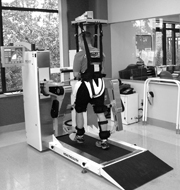MU Researchers Study Effectiveness of Robotic Gait-Assisted Therapies for Stroke Victims
Oct. 27, 2008
Story Contact: Jennifer Faddis, (573) 882-6217, FaddisJ@missouri.edu
COLUMBIA, Mo. – When it comes to recovering mobility after a stroke, therapists say that every step counts. Two University of Missouri researchers recently studied robotic gait-assisted therapy to see if it is the best way to make steps count for patients with neurological injuries.
Stephen Sayers and Jeffrey Krug, researchers in the MU School of Health Professions Department of Physical Therapy, compared traditional types of patient mobility – overground walking and body weight supported treadmill training (BWSTT) –to the newest technique, robotic gait-assisted training. The researchers found that robotic gait-assisted training may be most beneficial; however, each therapy has drawbacks and benefits.
Sayers and Krug found robotic gait-assisted therapy was most advantageous for stroke survivors and therapists. Using the robotic machine, patients are fitted with a special harness attached to an overhead lift. The lift raises patients into standing positions over the treadmill. Articulated arms mounted on each side attach to the patients’ ankles and knees. The machine then simulates a walking motion without manual human help.
“Physical therapists can control the speed of the treadmill and the device encourages the proper motion of walking which then activates specific neurological mechanisms in the patients’ bodies that help them to walk,” Krug said. “The robot allows for more practice time and teaches proper gait; patients cannot do it incorrectly.”
Overground training, in which patients are manually assisted in walking simulations by multiple therapists, has been part of the physical therapy practice for decades. Sayers and Krug said drawbacks to this approach include insufficient space for ambulation and therapist fatigue. In BWSTT approaches to gait therapy, patients use harnesses for support and movable footplates that simulate the stance of walking while therapists manually move their legs forward on treadmills. While this approach decreases some of the physical burden on therapists, drawbacks for patients include the lack of knee and hip control offered by the device, causing a risk of hyperextension of the knee or practice of an incorrect gait pattern.
“Without the robot, therapists become fatigued and a large area for walking practice is needed,” Krug said. “Often, time is spent on exercises to improve balance, coordination and strength, which doesn’t always translate to walking.”
The study – “Robotic Gait-Assisted Therapy in Patients with Neurological Injury” – was published in Missouri Medicine.
-30-





 Photos (2):
Photos (2):